
Australian art is a broad spectrum of art created in or about Australia, or by Australians overseas, spanning from prehistoric times to the present day. The art forms include, but are not limited to, Aboriginal, Colonial, Landscape, Atelier, and Contemporary art.
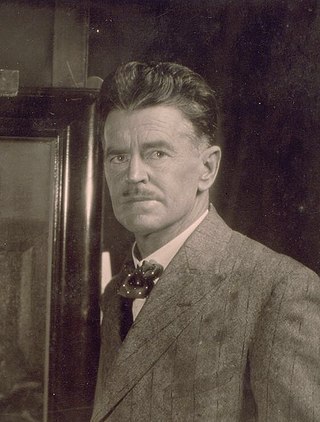
William Beckwith McInnes was an Australian portrait painter, winner of the Archibald Prize seven times for his traditional style paintings. He was acting-director at the National Gallery of Victoria and an instructor in its art school.
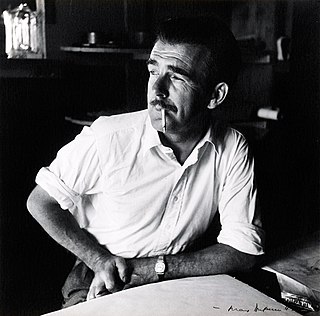
Sir William Dobell was an Australian portrait and landscape artist of the 20th century. Dobell won the Archibald Prize, Australia's premier award for portrait artists on three occasions. The Dobell Prize is named in his honour.
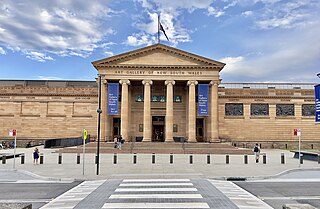
The Art Gallery of New South Wales (AGNSW), founded as the New South Wales Academy of Art in 1872 and known as the National Art Gallery of New South Wales between 1883 and 1958, is located in The Domain, Sydney, Australia. It is the most important public gallery in Sydney and one of the largest in Australia.

George Washington Thomas Lambert was an Australian artist, known principally for portrait painting and as a war artist during the First World War.
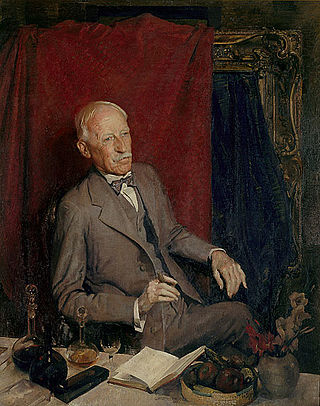
Julian Rossi Ashton was an English-born Australian artist and teacher. He is best known for founding the Julian Ashton Art School in Sydney and encouraging Australian painters to capture local life and scenery en plein air, greatly influencing the impressionist Heidelberg School movement.
William Edwin Pidgeon, aka Bill Pidgeon and Wep, (1909–1981) was an Australian painter who won the Archibald Prize three times. After his death, cartoonist and journalist Les Tanner described him: "He was everything from serious draftsman, brilliant cartoonist, social observer, splittingly funny illustrator to multiple Archibald prizewinner.

Ben Quilty is an Australian artist and social commentator, who has won a series of painting prizes: the 2014 Prudential Eye Award, 2011 Archibald Prize, and 2009 Doug Moran National Portrait Prize. He has been described as one of Australia's most famous living artists.

George James Coates was an Australian painter, primarily dealing with portraits. He worked as an official war artist to the Australian government in 1919, and from then on specialised in war subjects until his death in 1930.

Shearing the Rams is an 1890 painting by Australian artist Tom Roberts. It depicts sheep shearers plying their trade in a timber shearing shed. Distinctly Australian in character, the painting is a celebration of pastoral life and work, especially "strong, masculine labour", and recognises the role that the wool industry played in the development of the country.

Alethea Mary Proctor was an Australian painter, print maker, designer and teacher who upheld the ideas of 'taste' and 'style'.

Florence Ada Fuller was a South African-born Australian artist. Originally from Port Elizabeth, Fuller migrated as a child to Melbourne with her family. There she trained with her uncle Robert Hawker Dowling and teacher Jane Sutherland and took classes at the National Gallery of Victoria Art School, becoming a professional artist in the late 1880s. In 1892 she left Australia, travelling first to South Africa, where she met and painted for Cecil Rhodes, and then on to Europe. She lived and studied there for the subsequent decade, except for a return to South Africa in 1899 to paint a portrait of Rhodes. Between 1895 and 1904 her works were exhibited at the Paris Salon and London's Royal Academy.
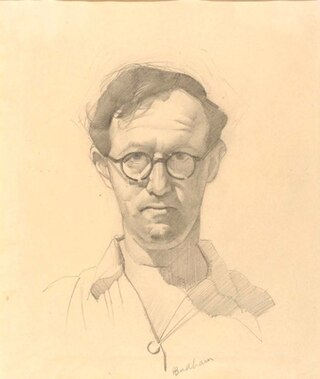
Herbert Edward Badham (1899–1961) was an Australian realist painter and art teacher.
Across the Black Soil Plains is a 1899 painting by Australian artist George Washington Lambert. The landscape depicts a team of draft horses pulling a wagon heavily laden with wool bales. Lambert's painting was awarded the Wynne Prize in 1899.

Polly Hurry, was an Australian painter. She was a founding member of the Australian Tonalist movement and part of the Twenty Melbourne Painters Society.

Weighing the Fleece is a 1921 painting by Australian artist George Washington Lambert. It is part of the collection of the National Gallery of Australia in Canberra.
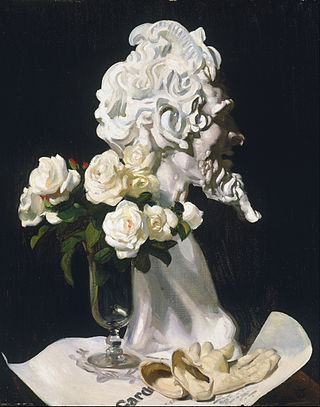
Pan Is Dead (Still Life) is a 1911 still life painting by Australian artist George Washington Lambert. The painting depicts "a sculpted head of Pan beside white gloves and a glass vase filled with white roses". Lambert created the bust of Pan as part of a costume for a character he played in a tableau vivant, The awakening of Pan, created in 1909 by the wife of the artist Philip Connard.
Lambert constructed a conceit in which he played upon the difference between how things appear on the surface of the canvas and how they are in reality. He abrogated the difference between the solid bust of Pan and the bunch of fragile white roses in the glass vase beside it by making the sculpted curls in Pan's hair resemble roses and by using sharply defined edges to 'sculpt' the flowers.

Miss Collins is a 1924 portrait painting by Australian artist William Beckwith McInnes. The painting depicts Miss Gladys Neville Collins, the daughter of J.T. Collins, lawyer, Victorian State Parliamentary draughtsman, and trustee of the Public Library, Museums and National Gallery of Victoria.

Self-portrait with gladioli is a 1922 oil-on-canvas painting by Australian artist George Washington Lambert. The painting, a self-portrait, depicts Lambert in a brown velvet gown, wearing a purple scarf with a vase holding a gladiolus in front of him.

















